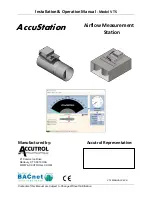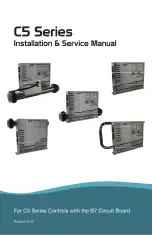
Page 28
B2203472
10006274
CHECKING THERMOSTAT VOLTAGES
DISCHARGE AIR SENSOR CHECKOUT
Troubleshooting (continued)
Using a digital voltmeter (DVM) measure the AC voltage supplied at the R and C terminals of the Thermostat
inputs on the control panel for the zone in question. This voltage should be same as the voltage supplied to the
control panel 24VAC terminals. Make a call for heat, cooling or fan. Measure the voltage across the terminal that
should be energized (i.e. W for heat, Y for cooling, etc.) and the C terminal. This should be the same voltage as
there is between the R and C terminals. Measure the voltage across a terminal that should NOT be energized
and the C terminal; this voltage should be zero.
The discharge air sensor is a temperature dependent resistor; the higher the temperature, the lower the
resistance. In order to confirm the sensor is working, both sensor leads must be disconnected from the zone
panel board. Using a digital voltmeter (DVM) set to read resistance, touch the leads from the sensor to the
probes of the DVM. Take care not to create a parallel resistance path through your body by touching both probes
with your fingers or a faulty reading will be obtained. At 77F, the resistance of the sensor will be 10K ohm. If the
sensor is cooler than 77F, the resistance will be higher, if it is warmer, the resistance will be lower. After reading
the resistance at room temperature, warm the tip of the sensor by holding it in the palm of your hand, and take
another resistance reading. This reading should be noticeable lower than the room temperature reading.
Temperature (°F)
Resistance (ohms)
65
13476
70
11884
75
10501
80
9298
85
8249
90
7333
The zone panel is well equipped to monitor the operation of the probe and determine if a failure has occurred.
The probe should be considered an integral (but replaceable) part of the zone panel. The zone panel will indicate
if the probe is operating improperly and needs to be replaced.
DAS shorted or open causing the panel to only respond
to zone 1 inputs while not closing any dampers.
Damper wired incorrectly. Spring open power close
dampers should be connected between
NO and C terminals.
DAS shorted or open causing the panel to only respond
to zone 1 inputs while not closing any dampers.
Damper motor faulty.
Damper opens when it should be closed.
Damper will not close.
DETECTING DAMPER PROBLEMS
Symptom
Possible Solution
Discharge air temperature dropped below set limit.
Allow discharge air to warm 10° above set limit and
allow timed off delay to expire.
Fan is running but no cooling and the COOL LED
is blinking. Dampers reposition while the fan is on.
DETECTING HEATING, COOLING AND FAN PROBLEMS (continued)
Symptom
Possible Solution
Discharge air temperature exceeds set limit.
Allow discharge air to cool 10° below set limit and
allow timed off delay to expire.
Fan is running but no heat and the HEAT LED is
blinking. Dampers reposition while the fan is on.
Summary of Contents for Zoning System LZP-4
Page 2: ...Page 2 FIGURE 1 LZP 4 CONTROL PANEL SCHEMATIC...
Page 20: ...Page 20 System Setup Flowchart...
Page 21: ...Page 21 System Setup Flowchart continued...
Page 22: ...Page 22 System Setup Flowchart continued...
Page 23: ...Page 23 System Setup Flowchart continued...
Page 24: ...Page 24 System Setup Flowchart continued...

































